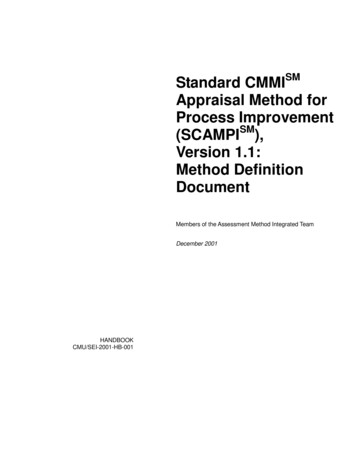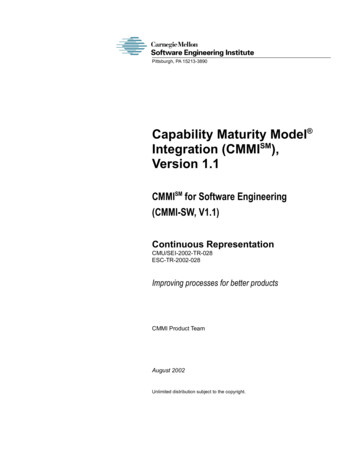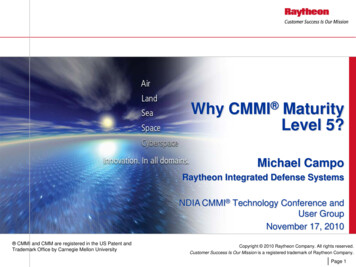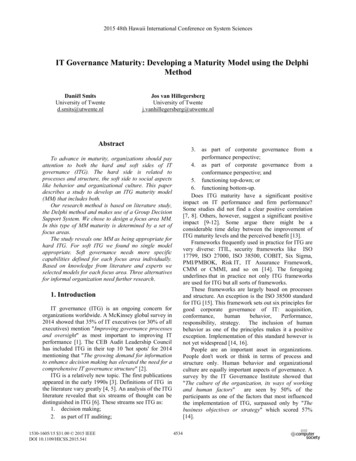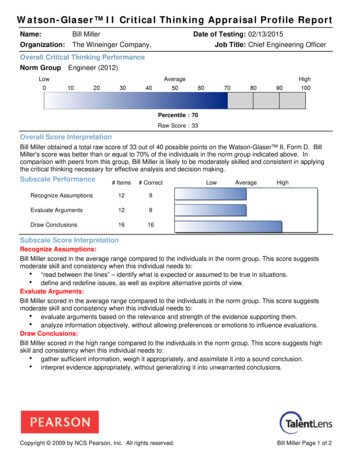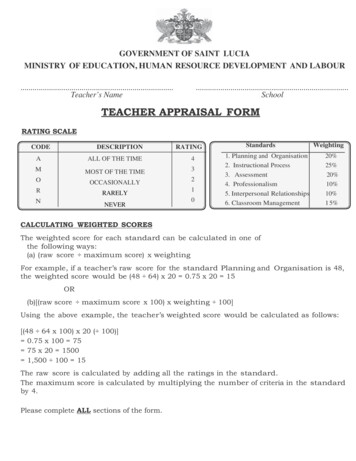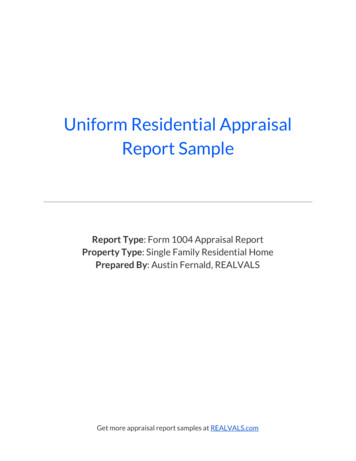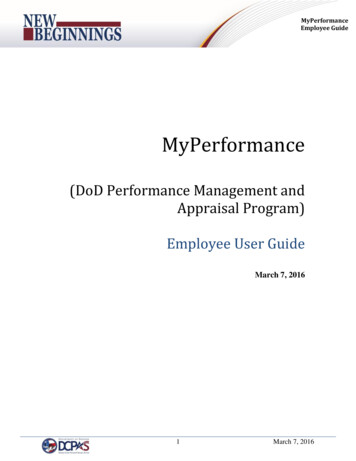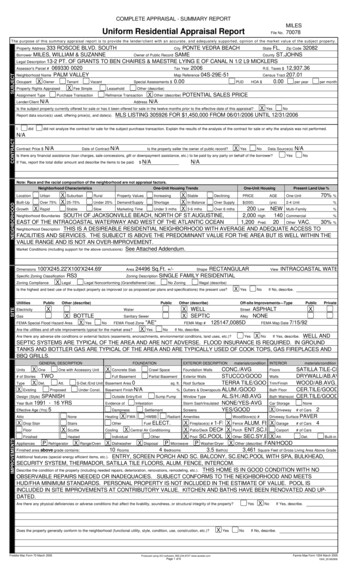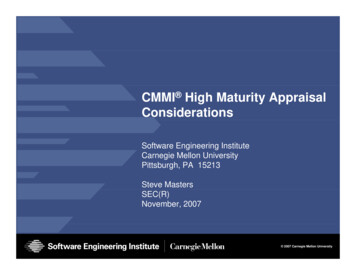
Transcription
CMMI High Maturity AppraisalConsiderationsSoftware Engineering InstituteCarnegie Mellon UniversityPittsburgh, PA 15213Steve MastersSEC(R)November, 2007 2007 Carnegie Mellon University
AcknowledgementsThe CMMI implementation examples in the second half of this tutorialare derived from the October 17,, 2007 CMMI Workshopp presentationpIfYou Are Living the “High Life”, You Are Living the Informative Materialby Rusty Young, Bob Stoddard, and Mike Konrad.CMMI High Maturity Appraisal ConsiderationsNovember 2007 2007 Carnegie Mellon University2
OutlineSCAMPISM OverviewHigh Maturity Skills in the SLA BOKStatistical and Quantitative ThinkingOrganizational Process Performance (OPP)Quantitative Project Management (QPM)Casual Analysis and Resolution (CAR)Organizational Innovation and DeploymentSummarySM SCAMPI and SCAMPI Lead Appraiser are service marks of Carnegie Mellon UniversityCMMI is registeredgin the US Patent and Trademark Office byy Carnegieg Mellon UniversityyCMMI High Maturity Appraisal ConsiderationsNovember 2007 2007 Carnegie Mellon University3
SCSCAMPIOOVERVIEWCMMI HIGH Maturity Appraisal ConsiderationsNovember 2007 2007 Carnegie Mellon University4
Three Classes of AppraisalsCharacteristicClass CClass BClass AAmount of objective evidenceLowMediumHighRatings generatedNoNoYesResource needsLowMediumHighSmallMediumLargeTeam SizeCMMI High Maturity Appraisal ConsiderationsNovember 2007 2007 Carnegie Mellon University5
SCAMPI FamilySCAMPI C: provides a wide rangeof options, includingcharacterization of plannedapproaches to processimplementation according to ascale defined by the userSCAMPI B: provides options inmodel scope and organizationalscope but characterization ofscope,practices is fixed to one scale andis performed on implementedpracticesSCAMPI A: Is the most rigorousmethod, and is the only methodthat can result in ratingsbreadth of tailoringCBdepth ofinvestigationACMMI High Maturity Appraisal ConsiderationsNovember 2007 2007 Carnegie Mellon University6
Approach, Deployment, lowRedSCAMPI family methods can be used in a range from looking at the approach planned to satisfy processimprovement goals, to examining deployment of processes in selected instances inan organizational unit (OU), to benchmarkingg the institutionalization of CMMI in an OUCMMI High Maturity Appraisal ConsiderationsNovember 2007 2007 Carnegie Mellon University7
SCAMPI Class A ObjectivesProvide an accurate picture of the organization’s processes relative toCMMI: Understand the current implemented process. Identify process weaknesses (and strengths) in theorganizational unit. Determine degree of satisfaction of CMMI Process Area goalsinvestigated.g Assign ratings, if requested by appraisal sponsor.CMMI High Maturity Appraisal ConsiderationsNovember 2007 2007 Carnegie Mellon University8
Comparison to SCAMPI ASCAMPI B provides more optionsin model scope and organizationalscope, but characterization of practicesis fixed to one scale and is performed onpppractices.ImplementedSCAMPI C provides a wide range of options,including characterization of plannedapproachesh tto process implementationi lt tiaccording to a scale defined by theorganization and appraisal team.This allows SCAMPI C to be used in aplanning and consultation context.CABBACCMMI High Maturity Appraisal ConsiderationsNovember 2007 2007 Carnegie Mellon University9
Discipline Model (CMMI-DEV)In making inferences about the extent to which practices are or are notin pplace ((i.e.,, implemented),p), appraisersppare expectedpto draw uponp theentire model document as the basis for their decisions.Examples glossary definitions front matter subpracticesbti related process areasCMMI High Maturity Appraisal ConsiderationsNovember 2007 2007 Carnegie Mellon University10
Determination of Practice ImplementationAssumptions1 The appraisal team understands the context in which the1.practice is being implemented.2. The appraisal team understands the practice intent.The basic approach to determination of practice implementation is to1. Characterize the degree to which the practice is implemented.2. Note any factors which should be considered in addition as theinstantiation data is aggregated (strengths, weaknesses, etc.).CMMI High Maturity Appraisal ConsiderationsNovember 2007 2007 Carnegie Mellon University11
SCAMPI A Practice CharacterizationFully Implemented (FI) Direct artifacts present and adequate Supported by indirect artifact and/or affirmation No weaknesses notedLargely Implemented (LI) Partially Implemented (PI) Not Implemented (NI) Not Yet (NY) Direct artifacts present and adequate Supported by indirect artifact and/or affirmation One or more weaknesses notedDirect artifacts absent or judged inadequate Indirect artifacts or affirmations indicate some aspects ofthe practice are implemented One or more weaknesses notedOR Direct artifacts present and adequate No other evidence supports direct artifacts One or more weaknesses notedDirect artifacts absent or judged inadequate No other evidence supports the practice One or more weaknesses notedProject has not yet reached the stage in lifecycleCMMI High Maturity Appraisal ConsiderationsNovember 2007 2007 Carnegie Mellon University12
SCAMPI B: Practice CharacterizationLabelMeaningRedThe intent of the model practice is judged to be absent or poorlyaddressed in the set of implemented practices – gaps or issues that willprevent goal achievement, if the deployment occurred in this way acrossthe organizational unit, were identified.YellowThe intent of the model practice is judged to be partially addressed in theset of implemented practices – some gaps or issues were identified,which might threaten goal achievement if the deployment occurred inthis way across the organizational unit.GreenThe intent of the model practice is judged to be adequately addressed inthe implemented set of practices examined – in a manner that wouldsupport goal achievement, if the practice were deployed across theorganizational unitunit.Not Yet(NY)Project has not yet reached the stage in lifecycle.CMMI High Maturity Appraisal ConsiderationsNovember 2007 2007 Carnegie Mellon University13
SCAMPI C: Example Characterization Scale-AppraisalFocus “Approach”ApproachLabelMeaningLOWThe intent of the model practice is judged absent, or inadequatelyaddressed in the approach – goal achievement is judged unlikelybecause of this absence or inadequacy.MEDIUMThe intent of the model practice is judged to be partially addressed in theapproach – and only limited support for goal achievement is evident.HIGHThe intent of the model practice is judged to be adequately addressed inthe set of practices (planned or deployed) – in a manner that supportsachievement of the goal in the given process context.CMMI High Maturity Appraisal ConsiderationsNovember 2007 2007 Carnegie Mellon University14
Aggregation Across InstantiationsWhen there is objective evidence for two or more instantiations of apractice,, how is the organizationalpgunit characterization derived?SCAMPI A and SCAMPI B provide aggregation rules to assist the teamin efficiently, effectively, and consistently aggregating acrossinstantiations.instantiationsCMMI High Maturity Appraisal ConsiderationsNovember 2007 2007 Carnegie Mellon University15
SCAMPI A Aggregation RulesInstantiationsOutcomeAll FI/NY withith att leastlt one FIFIAll LI/FI/NY with at least one LILIAt least one LI/FI and at least onePI/NILI or PI*All PI/NI/NY with at least one PIPIAll NI/NY withith at least one NINIAll NYNY*** Team judgment is applied to choose LI or PI based on whether the weaknessesweaknesses,in aggregate, have a significant negative impact on goal achievement** If all instantiations in the OU have not reached the stage in the OU to haveimplemented a practice, no associated goal rating can be givenCMMI High Maturity Appraisal ConsiderationsNovember 2007 2007 Carnegie Mellon University16
SCAMPI B Aggregation Rules*OU CharacterizationInstance CharacterizationsRedAll instantiations characterized RedYellowAll instantiations characterized YellowGreenAll instantiations characterized GreenTeam judgment subject tobelow**belowAll conditions not included above**The OU characterization shall not be Red unless at least one instancecharacterizationht i ti iis RRedd andd shallh ll nott bbe GGreen unlesslatt lleastt one iinstancetcharacterization is Greenp*OptionalCMMI High Maturity Appraisal ConsiderationsNovember 2007 2007 Carnegie Mellon University17
Goal Rating Rules for SCAMPI AThe goal is rated “satisfied” if and only if There are no findings that document weaknesses associatedwith a goal.OR (a) All associated practices are characterized at theorganizational unit level as either Largely Implemented or FullyImplemented,p, and (b)( ) the aggregategg gof weaknesses associatedwith the goal does not have a significant negative impact on goalachievement.Otherwise the goal is rated “unsatisfiedOtherwise,unsatisfied.”CMMI High Maturity Appraisal ConsiderationsNovember 2007 2007 Carnegie Mellon University18
Rating Process Areas for SCAMPI AWhen a process area is determined to be outside of the organizational unit’sscope of work, the process area is designated as “not applicable” and is notrated. The only PA in CMMI-DEV that can be not applicable is SAM (asdetermined by the appraisal team).When a process area is outside of the appraisal reference model scope, theprocess area is designated as “out of scope” and is not rated. If the associatedfindings do not meet the method’s defined criteria for data coverage, theprocess area is designated as “not rated” and is not rated.Continuous RepresentationThe process area is given acapability level rating based uponthe highest level for which thegeneric goal is satisfied. If nogeneric goals are satisfied thenthe capability level rating is 00.Staged RepresentationThe process area is “satisfied” ifand onlyy if all of its specific andgeneric goals are rated“satisfied.”CMMI High Maturity Appraisal ConsiderationsNovember 2007 2007 Carnegie Mellon University19
Assigning Maturity Level in SCAMPI AA maturity level for a staged representation is achieved if all processareas within the level and within each lower level are either satisfied ornot applicable.A maturity level for a continuous representation is achieved if thecapability level profile is at or above the target profile for all processareas for that maturity level and all lower maturity levels in theequivalent staging, excepting those process areas that are designatedas not applicable.ppCMMI High Maturity Appraisal ConsiderationsNovember 2007 2007 Carnegie Mellon University20
HIGHG MATURITY SKILLSSS IN THESCAMPI LEAD APPRAISER BODYOF KNOWLEDGE (SLA BOK)CMMI HIGH Maturity Appraisal ConsiderationsNovember 2007 2007 Carnegie Mellon University21
What the SLA BOK isThe SCAMPI Lead AppraiserSM Body of Knowledge (SLA BOK) is a multidimensional view of the competencies and skills needed to be an effectiveand successful SCAMPI A Lead Appraiser. Codifies what Lead Appraisers have been doing Intended to document explicitly much that has been implicit for manyyearsThe SLA BOK has recently been published as an SEI technical report(CMU/SEI-2007-TR-019).CMMI High Maturity Appraisal ConsiderationsNovember 2007 2007 Carnegie Mellon University22
What the SLA BOK is notThe SLA BOK is not An articulation of detailed CMMI practice requirements (it doesnot replace the CMMI model) A definition of the requirements for conducting a SCAMPI Aappraisal (it does not replace the SCAMPI MDD) A detailed reference on the theory and concepts underlying HighMaturityy practicesp A definition of competencies required for process improvementconsulting or organizational change managementCMMI High Maturity Appraisal ConsiderationsNovember 2007 2007 Carnegie Mellon University23
SLA BOK UsesServes as the foundation for Lead Appraiser certification process Selecting competencies that are suitable to measure through awritten examination Guidingg the writingg and validatingg of qquestions,, and supportingppg theidentification of test coverage requirementsIn conjunction with the Competency Lifecycle Framework, serves as thebasis for integrated Lead Appraiser curriculum and training developmentServes as the basis for updating the Lead Appraiser ObservationWorksheet, along with guidelines and criteria for ObservationsIndividuals may use the SLA BOK to understand what is expected ofpeople who become Lead Appraisers, or to find areas for professionaldevelopmentCMMI High Maturity Appraisal ConsiderationsNovember 2007 2007 Carnegie Mellon University24
Architecture of the SLA BOKHorizontal axis shows Nine Competency Clusters.Vertical axis shows Five Knowledge Areas(based on MDD activity phases).CMMI High Maturity Appraisal ConsiderationsNovember 2007 2007 Carnegie Mellon University25
SLA BOK Matrix Fold-OutThe SLA BOK matrix, with all Competency Clusters, Knowledge Areas,and top-level CompetenciesCompetencies, has been included as a one-sheet fold-out inappendix B of the Technical Report.Some statistics Of the 45 cells in the matrix, only 1 has no Competenciesidentified. 105 Competencies have been identifiedidentified. Of these, 9 contain high maturity skills.CMMI High Maturity Appraisal ConsiderationsNovember 2007 2007 Carnegie Mellon University26
The Evolution of High Maturity SkillsWith the exception of a few specific skills (mostly related to high maturity modelunderstanding),g), there are no differences between the competenciespneeded forhigh maturity appraisals and the competencies needed for appraisals in general. At the SLA BOK workshop: Development began with a separate “Judgingg Maturityy Processes” Knowledgeg Area.High Developer review baseline: Analysis led to combining the JudgingProcesses and Judging High Maturity Processes KAs, and resulted in afew stand-alone Highg Maturityy Competenciespand some scattered HighgMaturity Considerations within other Competencies. Stakeholder review baseline: It became clear that every instance of aHigh Maturity Competency has or should have an ML/CL 2/3 Competencyequivalent. Final outcome: All Competencies are applicable; a few have High MaturitySkills.CMMI High Maturity Appraisal ConsiderationsNovember 2007 2007 Carnegie Mellon University27
Competencies that contain HM SkillsCMP 3.2.1Selecting appraisal team membersCMP 55.5.252Delivering appraisal resultsCMP 6.1.2Clarifying the OU’s process improvement historyCMP 6.1.3Understanding the OU’s business context and driversfor process improvementCMP 6.2.1Identifying and managing language issuesCMP 66.4.444Recognizing mature organizational behaviorCMP 7.2.1Preparing appraisal team members for modelinterpretationCMP 7.4.1Evaluating implementations of CMMI practicesCMP 8.5.1Completing the Appraisal Disclosure Statement (ADS)CMMI High Maturity Appraisal ConsiderationsNovember 2007 2007 Carnegie Mellon University28
CMP 3.2.1 Selecting appraisal team membersHigh Maturity SkillsDetermining when appraisal team members with specializedknowledge and experience are needed to judge high maturity practicesCMMI High Maturity Appraisal ConsiderationsNovember 2007 2007 Carnegie Mellon University29
CMP 5.5.2 Delivering appraisal resultsHigh Maturity SkillsExplaining results in detail and answering questions on the technicalbasis for characterizations or ratings of the high maturity practices andgoalsCMMI High Maturity Appraisal ConsiderationsNovember 2007 2007 Carnegie Mellon University30
CMP 6.1.2 Clarifying the OU’s processimprovement historyHigh Maturity SkillsDetermining CMMI process implementations that may impact appraisalplanning including both high maturity practice implementations andother practice implementationsCMMI High Maturity Appraisal ConsiderationsNovember 2007 2007 Carnegie Mellon University31
CMP 6.1.3 Understanding the OU’s businesscontext and drivers for process improvementHigh Maturity SkillsDetermining the relationship of business goals and concerns to thedefinition of quantitative targets, the establishment of baselines andmodels, and the selection of subprocesses to be statistically controlledCMMI High Maturity Appraisal ConsiderationsNovember 2007 2007 Carnegie Mellon University32
CMP 6.2.1 Identifying and managing languageissuesHigh Maturity SkillsPreparing appraisal teams to recognize terminologyterminology, based onstatistical and quantitative methods, that OU’s use when describinghigh maturity activitiesCMMI High Maturity Appraisal ConsiderationsNovember 2007 2007 Carnegie Mellon University33
CMP 6.4.4 Recognizing mature organizationalbehaviorHigh Maturity SkillsUnderstanding the OU and project behaviors that demonstrate highmaturityIdentifying the processes or subprocesses that are being statisticallycontrolledUnderstanding the intent of CMMI high maturity practicesUnderstandingUd t di howhhighhi h maturityt it conceptst are appliedli d appropriatelyi t l iindifferent contextsCMMI High Maturity Appraisal ConsiderationsNovember 2007 2007 Carnegie Mellon University34
CMP 7.2.1 Preparing appraisal team members formodel interpretationHigh Maturity Skillsg what knowledgeg is needed for a ggiven appraisalDeterminingClarifying what knowledge is available on the appraisal teamClarifying high maturity concepts for appraisal team membersClarifying the difference between quantitative management and statisticalmanagementExplaining why maturity level 3 behavior is required to address the maturitylevel 4 process areasExplaining that the maturity level 5 process areas depend on the organization’smaturity level 4 quantitative baselines, models, and methodsAddressing common misinterpretations and misconceptions associated withhi h maturityhight itEnsuring that all members of the appraisal team have adequate knowledge ofhigh maturity concepts and techniquesCMMI High Maturity Appraisal ConsiderationsNovember 2007 2007 Carnegie Mellon University35
CMP 7.4.1 Evaluating implementations of CMMIpracticesHigh Maturity Skillsg the quantitative and statistical managementgtechniques that canUnderstandingbe applicable depending on the contextJudging the validity of the application of the selected statistical methodsEvaluating whether statistically managed subprocesses are important inachievinghi i ththe bbusinessigoalsl off ththe OUEvaluating whether approaches to establishing quality and processperformance objectives meet model expectationsU d t di process performanceUnderstandingfbbaselinesliandd ththeiri usesUnderstanding process performance models and their usesEvaluating whether causal analysis and resolution techniques meet modelexpectationst tiEvaluating whether an OU’s process for selection and deployment ofincremental and innovative improvements meets model expectationsCMMI High Maturity Appraisal ConsiderationsNovember 2007 2007 Carnegie Mellon University36
CMP 8.5.1 Completing the Appraisal DisclosureStatement (ADS)High Maturity SkillsKnowing the information that must be included in the ADS and the finalfindings related to high maturity appraisalsCMMI High Maturity Appraisal ConsiderationsNovember 2007 2007 Carnegie Mellon University37
STATISTICALSS CANDQUANTITATIVE THINKINGCMMI HIGH Maturity Appraisal ConsiderationsNovember 2007 2007 Carnegie Mellon University38
What Is High Maturity All About?High maturity involves the following qualities: Statistical and other quantitative methods are used,used at theorganizational and project levels, to understand past and predict futurequality and process performance. Organizations establish objectives for quality and process performancebased on their business objectives. Projects establish their objectives based on those of the organizationand the needs of c
CMMI High Maturity Appraisal Considerations Software Engineering Institute Carnegie Mellon UniversityCarnegie Mellon University Pittsburgh, PA 15213 Steve Masters SEC(R) November, 2007
